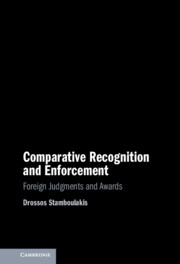Book contents
- Comparative Recognition and Enforcement
- Comparative Recognition and Enforcement
- Copyright page
- Contents
- Foreword
- Preface
- 1 Introduction
- Part I Transnational Recognition and Enforcement
- 2 ‘Global’ Recognition and Enforcement Approaches
- 3 Uniform Recognition and Enforcement in Europe
- 4 The Commonwealth Model and Common Law Recognition and Enforcement
- 5 Comparative Analysis of Recognition and Enforcement
- Part II Towards Increased Prospects for Judgments Recognition and Enforcement?
- Bibliography
- Index
2 - ‘Global’ Recognition and Enforcement Approaches
from Part I - Transnational Recognition and Enforcement
Published online by Cambridge University Press: 10 November 2022
- Comparative Recognition and Enforcement
- Comparative Recognition and Enforcement
- Copyright page
- Contents
- Foreword
- Preface
- 1 Introduction
- Part I Transnational Recognition and Enforcement
- 2 ‘Global’ Recognition and Enforcement Approaches
- 3 Uniform Recognition and Enforcement in Europe
- 4 The Commonwealth Model and Common Law Recognition and Enforcement
- 5 Comparative Analysis of Recognition and Enforcement
- Part II Towards Increased Prospects for Judgments Recognition and Enforcement?
- Bibliography
- Index
Summary
Chapter 2 traces the emergence and approach of ‘global’ recognition and enforcement. These approaches are now instrumentally bifurcated, premised upon whether a decision that is to be recognised or enforced is a product of a particular dispute resolution mechanism (arbitration or litigation), and whether an exclusive choice of court has been made (or, failing such a choice, the ‘default’ operation of jurisdictional rules). The reasons for doing so are explored in the context of the modern negotiations at the Hague Conference towards a harmonised private international law approach to the recognition and enforcement and judgments. The end product of these negotiations are, of course, the 2005 Choice of Court Convention and the 2019 Judgments Convention. In terms of their international reach and acceptance, these conventions are in an embryonic form compared to widely implemented “backbone” of arbitration recognition and enforcement (in the 1958 New York Convention).
Keywords
- Type
- Chapter
- Information
- Comparative Recognition and EnforcementForeign Judgments and Awards, pp. 31 - 62Publisher: Cambridge University PressPrint publication year: 2022

